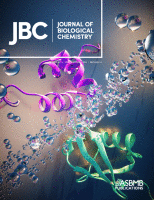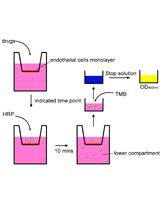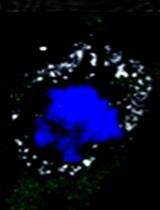- EN - English
- CN - 中文
Generation and Implementation of Reporter BHK-21 Cells for Live Imaging of Flavivirus Infection
黄病毒感染活体显像报告细胞BHK-21的制备与实施
发布: 2021年03月05日第11卷第5期 DOI: 10.21769/BioProtoc.3942 浏览次数: 4142
评审: Yelena BernadskayaSandeep Kumar UpadhyayAnonymous reviewer(s)

相关实验方案
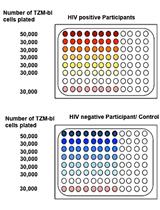
TZA, 一种基于敏感报告因子细胞学检测方法, 可用于准确快速量化静息CD4+ T细胞中可诱导的且复制能力强的潜伏HV-1
Anwesha Sanyal [...] Phalguni Gupta
2019年05月20日 7635 阅读
Abstract
The genus Flavivirus within the family Flaviviridae includes many viral species of medical importance, such as yellow fever virus (YFV), Zika virus (ZIKV), and dengue virus (DENV), among others. Presently, the identification of flavivirus-infected cells is based on either the immunolabeling of viral proteins, the application of recombinant reporter replicons and viral genomes, or the use of cell-based molecular reporters of the flaviviral protease NS2B-NS3 activity. Among the latter, our flavivirus-activatable GFP and mNeptune reporters contain a quenching peptide (QP) joined to the fluorescent protein by a linker consisting of a cleavage site for the flavivirus NS2B-NS3 proteases (AAQRRGRIG). When the viral protease cleaves the linker, the quenching peptide is removed, and the fluorescent protein adopts a conformation promoting fluorescence. Here we provide a detailed protocol for the generation, selection and implementation of stable BHK-21 cells expressing our flavivirus genetically-encoded molecular reporters, suitable to monitor the viral infection by live-cell imaging. We also describe the image analysis procedures and provide the required software pipelines. Our reporter cells allow the implementation of single-cell infection kinetics as well as plaque assays for both reference and native strains of flaviviruses by live-cell imaging.
Graphic abstract:
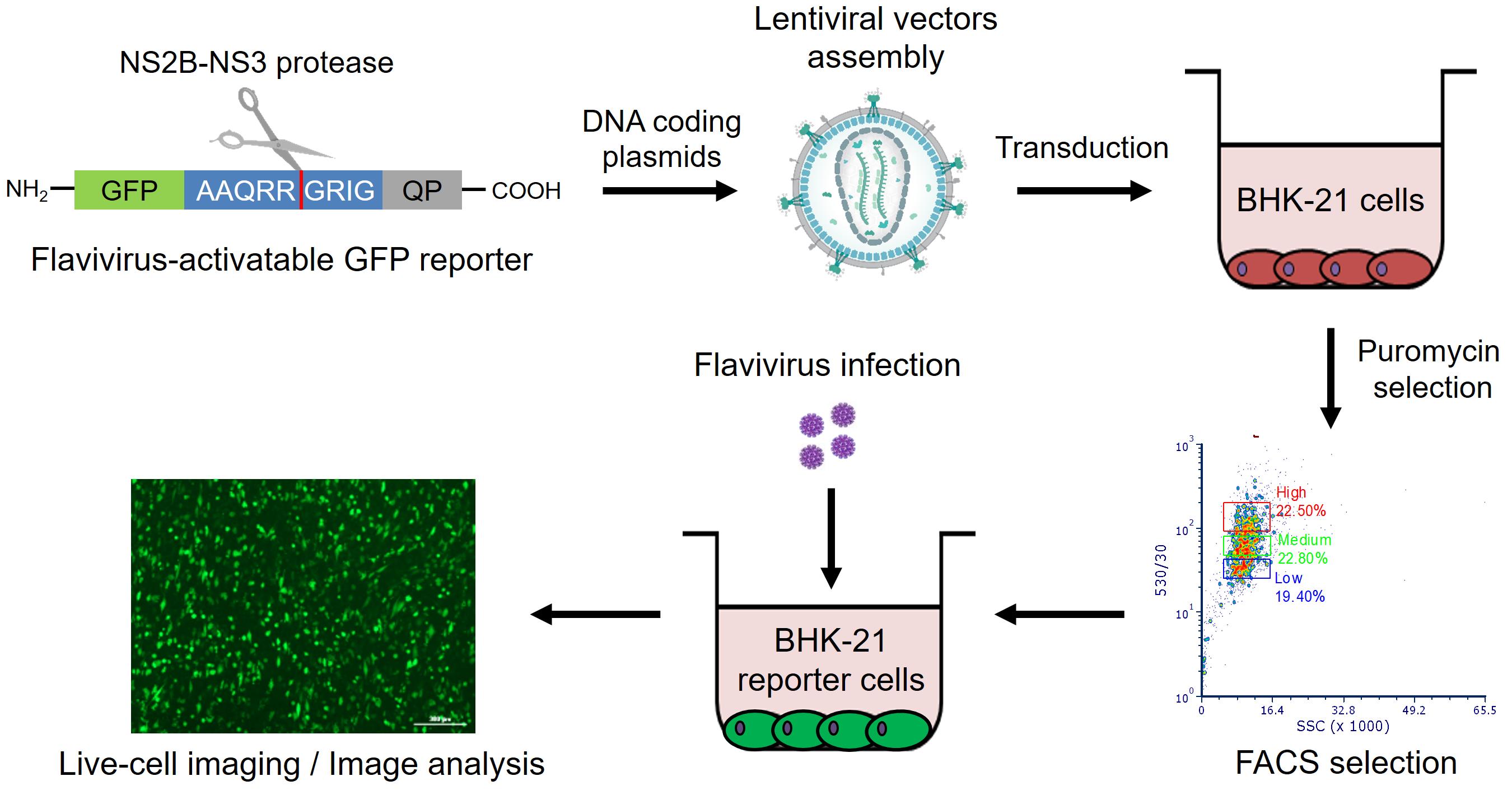
Workflow for the generation and implementation of reporter BHK-21 cells for live imaging of flavivirus infection.
Background
Flaviviruses represent an emerging and re-emerging global threat that cause diseases both in animals and humans, including many medically relevant viruses like yellow fever virus (YFV), West Nile virus (WNV), Japanese encephalitis virus (JEV), dengue virus (DENV), and Zika virus (ZIKV), among others (Gould and Solomon, 2008). At present, the detection of flavivirus-infected cells is based on either the antibody labeling of viral proteins (Balsitis et al., 2008), the use of recombinant reporter replicons and viral genomes (Li et al., 2013; Schmid et al., 2015; Xie et al., 2016; Tamura et al., 2017; Kümmerer, 2018), or the application of genetically-encoded molecular reporters of the flavivirus NS2B-NS3 proteolytic activity (Medin et al., 2015; Hsieh et al., 2017; McFadden et al., 2018). Immunolabeling implies both fixation and permeabilization which hamper their implementation for studies in living cells. Reporter replicons and viral genomes are suitable for live-cell imaging assays, but they are restricted to particular molecular clones mainly derived from reference strains and thus, not applicable when working with clinical isolates or native viral strains. In this context, cell-based molecular reporters of the flaviviral proteases constitute a favorable alternative for the study of native flavivirus strains by live-cell imaging. Based on our recently published flavivirus-activatable GFP (FlaviA-GFP) and flavivirus-activatable mNeptune (FlaviA-mNeptune) reporters (Arias-Arias et al., 2020), here we describe in detail a protocol for the generation, selection, and implementation of stably-transduced reporter BHK-21 cells for live imaging of flavivirus infection in single cells and viral plaques. Furthermore, we provide a rationale for a software-based image analysis approach to demonstrate the capabilities of this reporter cell line for single-cell and viral-plaque tracking. In addition, we include the optimized CellProfiler analysis pipelines for studies employing this or other cell-based reporters. Our approach represents the first fluorescence activatable cell-based reporter system for monitoring the kinetics of infection by both reference and native strains of flaviviruses like DENV, ZIKV, and YFV using live-cell imaging.
Materials and Reagents
Cell culture flasks, 75 cm2 (Greiner Bio-One, CELLSTAR®, catalog number: 658175 )
Cell culture dishes, 100/20 mm (Greiner Bio-One, CELLSTAR®, catalog number: 664160 )
2 ml reaction tubes (Greiner Bio-One, catalog number: 623201 )
3 ml sterile syringes (Ultident Scientific, catalog number: BD-309657 )
Syringe filters 0.2 μm hydrophilic polyethersulfone, 32 mm diameter (Pall, Acrodisc®, catalog number: 4652 )
10 ml sterile syringes (Ultident Scientific, catalog number: BD-302995 )
Syringe filters 0.45 μm hydrophilic cellulose acetate, 28 mm diameter (Sartorius, Minisart®, catalog number: 16555 )
15 ml conical tubes (Greiner Bio-One, CELLSTAR®, catalog number: 188271 )
0.5 ml reaction tubes (Greiner Bio-One, catalog number: 667201 )
Hexadimethrine bromide (Merck, Sigma-Aldrich, catalog number: H9268 )
48-well cell culture plates (Greiner Bio-One, CELLSTAR®, catalog number: 677180 )
1.5 ml reaction tubes (Greiner Bio-One, catalog number: 616201 )
12-well cell culture plates (Greiner Bio-One, CELLSTAR®, catalog number: 665180 )
1.5 ml light protection reaction tubes (Greiner Bio-One, catalog number: 616283 )
Cell culture flasks, 25 cm2 (Greiner Bio-One, CELLSTAR®, catalog number: 690175 )
6-well cell culture plates (Greiner Bio-One, CELLSTAR®, catalog number: 657160 )
96-well black cell culture plates (Greiner Bio-One, µCLEAR®, catalog number: 655096 )
24-well cell culture plates (Greiner Bio-One, CELLSTAR®, catalog number: 662160 )
HEK 293T cells (ATCC, catalog number: CRL-3216 )
Plasmids:
pLenti-FlaviA-GFP-puro (a gift from Jorge L. Arias-Arias, Addgene plasmid #140088)
pLenti-CMV-FlaviA-mNeptune-puro (a gift from Jorge L. Arias-Arias, Addgene plasmid #140091)
pMD2.G (a gift from Didier Trono, Addgene plasmid #12259)
psPAX2 (a gift from Didier Trono, Addgene plasmid # 12260 )
LB agar plates with 100 µg/ml ampicillin (Merck, Sigma-Aldrich, catalog number: L5667 )
LB broth (Miller) (Merck, Sigma-Aldrich, catalog number: L2542 )
100 mg/ml ampicillin solution (Merck, Sigma-Aldrich, catalog number: A5354 )
NucleoSpin plasmid mini kit (Macherey-Nagel, catalog number: 740588.5 0)
DMEM, high glucose, GlutaMAXTM, pyruvate (Thermo Fisher Scientific, Gibco, catalog number: 10569044 )
Antibiotic-antimycotic 100× (Thermo Fisher Scientific, Gibco, catalog number: 15240062 )
Fetal bovine serum (FBS) qualified, heat inactivated (Thermo Fisher Scientific, Gibco, catalog number: 10438-026 )
Polyethylenimine (PEI), linear, MW 25000, transfection grade (Polysciences, PEI 25KTM, catalog number: 23966-1 )
UltraPureTM DNase/RNase-free distilled water (Thermo Fisher Scientific, Invitrogen, catalog number: 10977015 )
Hydrochloric acid, 36.5-38.0%, BioReagent (Merck, Sigma-Aldrich, catalog number: H1758 )
BHK-21 [C-13] (ATCC, catalog number: CCL-10 )
MEM, GlutaMAXTM supplement (Thermo Fisher Scientific, Gibco, catalog number: 41090101 ).
Sodium pyruvate, 100 mM (Thermo Fisher Scientific, Gibco, catalog number: 11360070 ).
PBS, pH 7.4 (Thermo Fisher Scientific, Gibco, catalog number: 10010023 ).
TrypLETM express enzyme (1×), no phenol red (Thermo Fisher Scientific, Gibco, catalog number: 12604013 )
Puromycin dihydrochloride from Streptomyces alboniger (Merck, Sigma-Aldrich, catalog number: P8833 )
Clinical isolate DENV-2/CR/13538/2007 (Instituto Costarricense de Investigación y Enseñanza en Nutrición y Salud, Cartago, Costa Rica) (Soto-Garita et al., 2016)
Vaccine strain YFV/US/17D/1937 (Sanofi Pasteur, YF-VAX®)
FluoroBriteTM DMEM (Thermo Fisher Scientific, Gibco, catalog number: A1896701 )
GlutaMAXTM supplement (Thermo Fisher Scientific, Gibco, catalog number: 35050061 )
Minimum essential medium eagle AutoModTM (Merck, Sigma-Aldrich, catalog number: M0769 )
Carboxymethylcellulose sodium salt (Merck, Sigma-Aldrich, catalog number: C4888 )
Sodium bicarbonate (Merck, Sigma-Aldrich, catalog number: S5761 )
Complete DMEM (see Recipes)
PEI solution (1 mg/ml) (see Recipes)
Polybrene solution (10 mg/ml) (see Recipes)
Complete MEM (see Recipes)
PBS 1% FBS (see Recipes)
Puromycin solution (10 mg/ml) (see Recipes)
FluoroBriteTM DMEM 2% FBS (see Recipes)
Plaque media 2% FBS (see Recipes)
Equipment
Biological safety cabinet (ESCO, Labculture® Class II, Type A2, catalog number: LA2-3A2-E )
CO2 incubator (Thermo Scientific, model: Forma Series II, catalog number: 3110 )
4 °C refrigerator (Thermo Scientific, Value Lab, catalog number: 20LREETSA )
-20 °C freezer (Thermo Scientific, Value Lab, catalog number: 20LFEETSA )
-80 °C freezer (Sanyo, VIP series, catalog number: MDF-U32V )
Water bath (PolyScience, catalog number: WBE20A12E )
Centrifuge (Eppendorf, model: 5810 )
Microcentrifuge (Eppendorf, model: 5418 )
Pipettes (Thermo Scientific, FinnpipetteTM F2 GLP Kit, catalog number: 4700880 )
Pipet filler (Thermo Scientific, S1, catalog number: 9511 )
Hemocytometer (Boeco, Neubauer improved, catalog number: BOE 13 )
Shaking incubator (Shel Lab, catalog number: SSI3 )
ThermoMixer® C block (Eppendorf, catalog number: 5382000015 )
Vortex mixer (Thermo Scientific, MaxiMixTM, catalog number: M16715Q )
Ultraviolet crosslinker (UVP, CL-100, catalog number: UVP95017401 )
NanoDropTM 2000 spectrophotometer (Thermo Scientific, catalog number: ND-2000 )
Steam sterilizer (Yamato, catalog number: SQ510 )
Water purification system (Merck, Milli-Q advantage A10)
Inverted microscope (Nikon, Eclipse, catalog number: TS100 )
Flow cytometer (BD Biosciences, BD AccuriTM C6)
Cell sorter (BD Biosciences, BD FACSJazzTM)
Automated fluorescence microscope (Biotek, Lionheart FX ) with:
CO2 gas controller (Biotek, catalog number: 1210012 )
Humidity chamber (Biotek, catalog number: 1450006 )
4× objective (Biotek, catalog number: 1220519 )
20× objective (Biotek, catalog number: 1220517 )
GFP filter cube (Biotek, catalog number: 1225101 )
465 nm LED cube (Biotek, catalog number: 1225001 )
Cy5 filter cube (Biotek, catalog number: 1225105 )
623 nm LED cube (Biotek, catalog number: 1225005 )
Software
Gen5 Image+ (Biotek, https://www.biotek.com)
CellProfiler 4.0 (Broad Institute, https://cellprofiler.org/releases)
Procedure
文章信息
版权信息
© 2021 The Authors; exclusive licensee Bio-protocol LLC.
如何引用
Readers should cite both the Bio-protocol article and the original research article where this protocol was used:
- Arias-Arias, J. L. and Mora-Rodríguez, R. (2021). Generation and Implementation of Reporter BHK-21 Cells for Live Imaging of Flavivirus Infection. Bio-protocol 11(5): e3942. DOI: 10.21769/BioProtoc.3942.
- Arias-Arias, J. L., MacPherson, D. J., Hill, M. E., Hardy, J. A. and Mora-Rodriguez, R. (2020). A fluorescence-activatable reporter of flavivirus NS2B-NS3 protease activity enables live imaging of infection in single cells and viral plaques.J Biol Chem 295(8): 2212-2226.
分类
微生物学 > 微生物细胞生物学 > 基于细胞的分析方法 > 报告基因实验
细胞生物学 > 细胞成像 > 活细胞成像
细胞生物学 > 基于细胞的分析方法 > 病毒性感染
您对这篇实验方法有问题吗?
在此处发布您的问题,我们将邀请本文作者来回答。同时,我们会将您的问题发布到Bio-protocol Exchange,以便寻求社区成员的帮助。
提问指南
+ 问题描述
写下详细的问题描述,包括所有有助于他人回答您问题的信息(例如实验过程、条件和相关图像等)。
Share
Bluesky
X
Copy link


